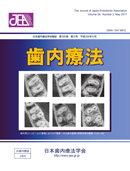
- 3 号 p. 117-
- 2 号 p. 61-
- 1 号 p. 3-
- |<
- <
- 1
- >
- >|
-
井澤 常泰2014 年 35 巻 3 号 p. 117-124
発行日: 2014年
公開日: 2017/09/30
ジャーナル フリーPDF形式でダウンロード (1635K)
-
—窩壁の超微構造と歯根表面の温度変化—新井 裕基, 吉嶺 嘉人, 松本 妃可, 佐藤 浩美, 木原 智子, 西原 正治, 赤峰 昭文2014 年 35 巻 3 号 p. 125-132
発行日: 2014年
公開日: 2017/09/30
ジャーナル フリーAbstract : The aim of this study was to observe the ultrastructures of root-end cavity walls prepared with Er:YAG laser, and to evaluate the temperature changes occurring on the root surface during irradiation. Human single-rooted teeth were used. After the crown was removed, the root canal was enlarged mechanically up to a size of #60. A 3-mm root-end resection was made perpendicular to the long axis of the root with a diamond bur at high speed under a continuous water spray. A root-end cavity 3 mm deep from the resected surface was prepared using Er:YAG laser with a flat-end tip (group A), Er:YAG laser with a cone-shaped tip following a flat-end tip (group B), and an ultrasonic device with a retrotip (group C). Laser energy was set at 80 mJ, and the repetition rate was 20 pps, with water and air cooling. For the thermographical observation, root canals were filled with a lateral condensation method.
The samples were sectioned longitudinally and examined using a scanning electron microscope. Group A presented a partially ablated dentin surface of the cavity wall, with a smear layer in part. Group B showed a totally ablated cavity surface with characteristic ring-like structures, without smear layer, with open dentinal tubules. The cavity wall of group C was mostly covered with a smear layer.
Temperature changes were recorded thermographically. The flat-end tip caused steep thermal increases of more than 10°C during lasing for 10 s. By contrast, the cone-shaped tip showed a temperature rise of approximately 2°C during lasing for 30 s.
These results suggest that the finishing preparation with Er:YAG laser irradiation might be feasible for the creation of a clean root-end cavity wall free of a smear layer.
抄録全体を表示PDF形式でダウンロード (5558K)
-
橋爪 英城, 北原 信也2014 年 35 巻 3 号 p. 133-137
発行日: 2014年
公開日: 2017/09/30
ジャーナル フリーAbstract : Invasive cervical resorption (ICR) is a type of external inflammatory root resorption. A 30-year-old patient showed, on intraoral radiograph and cone beam computed tomography, ICR of the upper-right central incisor caused by walking bleach. The tooth had a fistula, and showed draining not only from the fistula but also into a root canal. After root canal re-treatment and obturation, the ICR lesion in the pulp chamber was curetted with Nd:YAG laser, then mineral trioxide aggregate was used to fill the resorptive defect. Subsequently, the pulp chamber was restored with composite resin. Radiographs at 2, 4 and 6 months showed the suppression of resorption and endodontic success. Clinically, the tooth was asymptomatic, and no periodontal pocket was found at each point.
抄録全体を表示PDF形式でダウンロード (673K) -
牛窪 敏博2014 年 35 巻 3 号 p. 138-144
発行日: 2014年
公開日: 2017/09/30
ジャーナル フリーAbstract : Endodontic procedural errors in a curved canal make it difficult to negotiate the original canal due to the straight access. A deviation from the original canal curvature without communication with the periodontal ligament during root canal treatment is termed ledge formation.
The type of canal was found to have an effect on the incidence of ledging. The mesiobuccal, mesiolingual and canals of molars exhibited a significantly higher incidence than the distal and palatal canals. This report presents a case of a ledged mesiobuccal canal in a maxillary molar using modified conventional method to bypass and remove it.
抄録全体を表示PDF形式でダウンロード (2650K) -
勝海 一郎, 北村 和夫2014 年 35 巻 3 号 p. 145-152
発行日: 2014年
公開日: 2017/09/30
ジャーナル フリーAbstract : In the present study, we report the usefulness of cone-beam computed tomography (cone-beam CT) in the diagnosis and treatment of an internal resorption tooth, in which the absorption morphology was irregular.
The patient was a 34-year-old female who visited our hospital complaining of tenderness of labial gingiva on the maxillary left central incisor. According to clinical findings and cone-beam CT imaging, the case was diagnosed as chronic suppurative apical periodontitis caused by perforation of the root-side surface of irregular-type internal resorption. Based on the position and size of the internal resorption identified by the cone-beam CT, infected root canal treatment was performed on the diseased tooth. Root canal filling was carried out by system B and obtura Ⅱ. Thereafter, the enlarged cavity was restored by means of adhesive resin. Seven years have passed since then, and the results have been satisfactory.
Unlike circular-type internal resorption, continuity with the root canal is partially limited. In this respect, it is sometimes difficult to differentiate from external resorption even when X-ray photographing may be performed by eccentric projection. In the present study, the use of cone-beam CT proved to be very effective for the diagnosis and treatment of an irregular internal resorption tooth.
抄録全体を表示PDF形式でダウンロード (2771K)
- |<
- <
- 1
- >
- >|